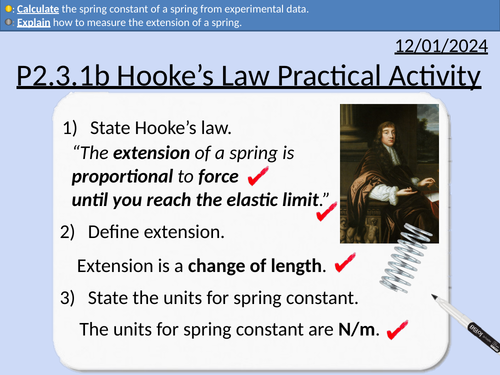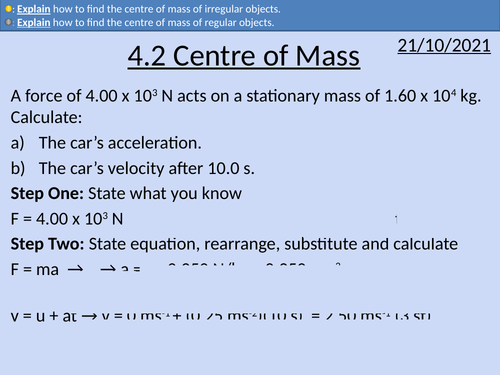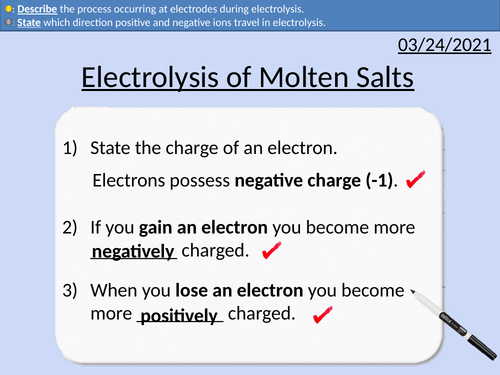496Uploads
163k+Views
70k+Downloads
Physics
Bundle

GCSE OCR Physics P5.1 Wave Behaviour
Resources for P5.1 GCSE OCR Physics Gateway 9-1 Triple and Combined (Higher and Foundation) is covered in this material.
Each lesson includes student activities and full worked answers.
Includes:
Definition of a wave
Mechanical waves
Electromagnetic waves
Transverse waves
Longitudinal waves
Amplitude
Wavelength
Frequency
Time period
Calculating frequency and equation
Relationship between frequency and wavelength when speed is constant.
Calculating time period from frequency with equations
The speed equation
Measuring distance and time
Simple experiment for the speed of sound
Improving experiments
Echoes
Speed of sound experiment with microphones and oscilloscope.
Ray diagrams
Absorption, reflection and transmission
Sonar
Ultrasound
Rearranging equation
Refraction
Relationship between wave speed and wavelength
Structure of the ear.
Frequency range of human hearing.
Explanation of the limited frequency range of humans.
Explanation for hearing deteriorating with age.

GCSE Physics: The Speed of Sound
This presentation covers OCR Gateway Physics 9-1 P5.1.2a the speed of sound and wave velocity. Includes student activities and full worked answers.
The speed equation
Measuring distance and time
Simple experiment for the speed of sound
Improving experiments
Echoes
Speed of sound experiment with microphones and oscilloscope.

GCSE Physics: Wave Velocity & Water Waves
This presentation covers OCR Gateway Physics 9-1 P5.1.2a Wave Velocity & Water Waves. Includes student activities and full worked answers.
Definition of mechanical waves
Water waves as a transverse waves
Converting from cm, mm, and km into m.
Definition and equation for frequency.
Wave speed equation
Rearranging equations
Ripple tank demonstration and explanation

GCSE Physics: Types of Waves
This presentation covers OCR Gateway Physics 9-1 P5.1.1a WaTypes of wave. Includes student activities and full worked answers.
Definition of a wave
Mechanical waves
Electromagnetic waves
Transverse waves
Longitudinal waves
Bundle

OCR A level Physics: Circular Motion
OCR A level Physics: Thermal Physics apart of the Module 5: Newtonian World and Astrophysics.
All presentations come with worked examples, solutions and homeworks.

OCR A level Physics: Exploring Centripetal Forces
OCR A level Physics: Centripetal Force and the Radian is a part of the Module 5: Newtonian world and astrophysics.
All presentations come with worked examples, solutions and homeworks with answers.

OCR A level Physics: Angular Acceleration
OCR A level Physics: Angular Acceleration and the Radian is a part of the Module 5: Newtonian world and astrophysics.
All presentations come with worked examples, solutions and homeworks with answers.

OCR A level Physics: Angular Velocity and the Radian
OCR A level Physics: Angular Velocity and the Radian is a part of the Module 5: Newtonian world and astrophysics.
All presentations come with worked examples, solutions and homeworks with answers.
Bundle

OCR A level Physics: Thermal Physics
OCR A level Physics: Thermal Physics apart of the Module 5: Newtonian World and Astrophysics.
All presentations come with worked examples, solutions and homeworks.

OCR AS Physics: Sensing Circuits
OCR AS Physics: Analysing Circuits is a part of the Module 4: Electrons, Waves, and Photons. PowerPoint with worked examples and homework.
Kirchhoff’s Laws for potential difference
Thermistors and LDRs in sensing circuits
Ratio of resistances and ratio of potential differences

GCSE Physics: Sensing Circuits
This presentation covers OCR Gateway Physics 9-1 P3.2.7 Sensing Circuits
Potential difference in series and parallel circuits
Lamps in series and parallel
Gravitational potential and potential difference
LDR and Thermistor in potential divider circuits
Using LDRs to control security lights
Using thermistors to control heating/cooling circuits
Exam questions with worked solutions

GCSE Physics: Resistance of a wire practical activity
This presentations covers the OCR Gateway Physics 9-1 P3.2.3 Resistance practical activity with the lenght of conductor and changing resistance.
Combining resistors in series
Ohm’s law
Rearranging equations
Measuring current
Measuring potential difference
Calculating resistance
Plotting the length of a conductor (wire) vs resistance of the conductor.
Interpreting data and stating relationships from data and graphs.

OCR Physics P2 Forces Revision
This revision PowerPoint should take approximately 5 hours of class time to complete.
This PowerPoint covers GCSE OCR Physics Gateway 9-1. Triple and combined (Higher and Foundation) is covered in this material.
** P2.1 Motion:**
Distance, time and speed
Vectors and Scalars
Acceleration
Distance-time graphs
Velocity-time graphs
Kinetic Energy
** P2.2 Newton’s Laws:**
Forces and Interactions
Free Body Diagrams
Newton’s First Law
Newton’s Second Law
Everyday Forces
Momentum
Work Done and Power
P2.3 Forces in Action:
Stretching springs
Stretching materials and storing energy
Gravitational Fields and Potential Energy
Turning Forces
Simple Machines
Hydraulics

GCSE Physics: Electrical Current Practical Activity
This presentation covers OCR Gateway Physics 9-1 P3.1.2 Electrical Current
Electron flow and conventional current
Measuring current with ammeters
Series and parallel circuits
Comparing current at junctions

GCSE Physics: Hooke's Law Practical
This PowerPoint presentation with worked examples and student questions covers:
• Definition of Hooke’s Law
• Converting from centimeters to meters
• Converting from millimeters to meters
• Calculating the spring constant from a gradient of a force-extension graph
• The parallax effect and good experimental practice
• Data analysis (calculating mean and significant figures).

OCR AS level Physics: Centre of Mass
OCR AS level Physics: Centre of mass is a part of the Module 3: Force and Motion
Full lesson PowerPoint with worked examples and homework with complete worked answers.

GCSE Chemistry: Electrolysis of molten salts
This PowerPoint presentation with worked examples and student questions covers:
• Naming electrolysis experimental set up
• PANIC convention for electrodes
• Electron transfers at electrodes
• Half-equations for anode and cathode

OCR Applied Science: 21.1 Regulatory Bodies
This PowerPoint presentation with worked examples and student activities covers: Topic 1.1 and 1.2 of Module 21: Product Testing Techniques.
Understand the influence of regulatory bodies on development of consumer products.
1.1 The relevant governing bodies that oversee product safety for
manufacturers and consumers of products.
1.2 How governing bodies influence how quality control is applied.

OCR Applied Science: 6.3 Electrical Properties
This PowerPoint presentation with worked examples and student activities covers:
Topic 6.3 of Module 1: Science Fundamentals of the OCR Applied Science Spec.
Current as flow of charge in a conductor.
Use the equation: I = ΔQ ÷ Δt
Ohm’s law illustrates the relationship of V ∝ I
Use the equation: potential difference (V) = current (A) × resistance
Use the equations for adding resistors in series and parallel
Compare electromotive force and potential difference
Use the equation: charge © = current (A) × time (s)
Use and recognise the equation for mean drift velocity
Use the equation: energy transferred (work done) (J) = charge © × potential difference (V)
Use the equation: energy transferred (J, kWh) = power (W, kW) × time (s, h)
Use the equation: power (W) = energy (J) ÷ time (s)
Bundle

OCR AS level Physics: Quantum Physics
OCR AS level Physics presentations for module 4: Quantum Physics.
All presentations are full lesson PowerPoints with worked examples and homeworks with complete worked answers.
The Photon Model
Energy of a single photon
Converting from electron-volts to Joules.
Frequency of the electromagnetic spectrum
Determining Plank’s constant with LEDs
Threshold potential difference difference
Photoelectric Effect
Threshold frequency
Producing photoelectrons
Kinetic energy of photoelectrons
Linking frequency and wavelength
The electromagnetic spectrum, frequency and energy.
Einstein’s Photoelectric Equation
The photoelectric equation
Work function and Kinetic Energy
Determining work function from a graph
Determining threshold frequency from a from graphical analysis.
Determining Plank’s constant from graphical analysis.
Wave Particle Duality
deBroglie wavelength equation
Diffraction of electrons and protons
Comparing wavelengths of particles with different masses
Kinetic energy and wavelength




















